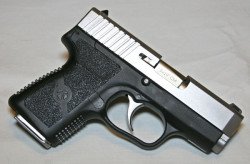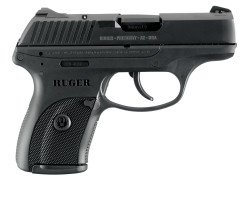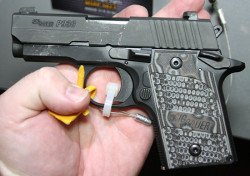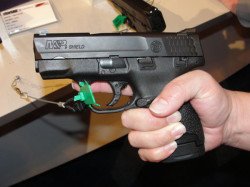
Today, even the term “snub” may be unfamiliar to 21st century warriors. For those who came in late, it might be best described as a small or medium frame revolver with a short (two inch to 2 1/2 inch) barrel.
A quarter of a century ago, “automania” took hold and cops everywhere were trading off their traditional revolvers for a self-loading pistol. In a few short years, the big switch was just about complete and, except for a few old-timers, it’s rare to encounter a police officer carrying a revolver in a duty holster.
Over time, the handguns which law enforcement officers have come to prefer for discreet carry have also changed. While small frame revolvers are still used in this role, most officers are far more comfortable using technology which functions like their service handgun.
The arms manufacturers have obliged and one can now select either a compact or subcompact version of most of the contemporary service pistols. These downsized variants have proven especially popular for many – if not most – concealed carry applications. On the downside, they are a bit chunky and don’t lend themselves for low profile carry under light clothing. They also tend to be too heavy or too large to serve as a backup gun for the uniformed patrol officer. These roles were once dominated by the snub revolver.
Small pocket pistols have existed for over 100 years and are indeed handy, but come up short in one critical area. Stopping potential is vastly inferior to the service caliber cartridges used in our duty pistols. Reliability is often an issue in this class of pistol, making it a less than optimum candidate for defensive applications.
The New Snub
Of late, an entirely new breed of pistol has made an impact on the market. The micro-nines are typically fresh designs not based on an existing service pistol platform. These pistols are roughly the same size as many classic pocket designs and are considerably thinner than either the compact or subcompact models. True, micro pistols are also available in .40 S&W or .45 ACP, but the 9mm variants seem to be the most popular. The micronines can easily fill the niche which was once the exclusive turf of the .38 Special snub revolver and offer even greater capabilities.
A Better Mousetrap
For discreet carry, micro-nine pistols hold any number of advantages over other handguns used in this role. While a small .380 ACP can be hidden more easily, the micro-nine enjoys a huge performance advantage. Muzzle energy is approximately twice that of a .380 ACP which translates to superior stopping potential.
At a recent ballistic workshop, a number of highly regarded .380 ACP and 9mm loads were fired into 10% ordnance gelatin covered with four layers of denim. Even when fired from pistols with barrel lengths of 3.5 inches or less, all of the 9mm loads penetrated to optimum levels and expanded to 1.5 times their original diameter. The only .380 ACP load which expanded reliably was CORBON/Glaser, Inc.’s 80-grain DPX hollow point. Most other loads failed to break 900 fps when fired through a Ruger LCP and recovered bullets exhibited only minor deformation.
With the better .38 Special loads, performance is much improved, but not on par with the 9mm. Snub revolvers, however, have a pretty steep learning curve, particularly for officers who cut their teeth on an autopistol. The micro-nines hold a slight advantage in ballistic potential, hold more ammunition, and are easier to reload. Even this snub aficionado will admit that the micro-nine may be the better tool.
I have long advocated carrying the biggest gun you can effectively hide. Hot summer weather and light clothing can make this a challenge – even when we’re talking chopped and channeled subcompacts. The height and length of micro-nines and subcompacts really aren’t much different, but the width is. These thin, lightweight pistols are easy to camouflage on a belt or stash in a pants pocket.
The current crop of micro-nines is fairly extensive and I’ve had the opportunity to check out a few different models. My experience is limited to a few different offerings, but, to date, I’m very impressed with what I’ve encountered. Let’s take a close look to see what they have to offer.
Kahr Arms
Kahr Arms markets a most extensive line of 9mm pistols, with close to 30 variants available. One can choose a Kahr pistol with either a stainless or polymer frame in three different size ranges. In addition to their top of the line offerings, Kahr also turns out a “C” series of plain-vanilla pistols minus some of the frills of their premium line, but with equally good shooting qualities.
Last year, I picked up a Kahr K9 which quickly became a frequent carry companion. This all stainless steel pistol measures 6.0 inches long and stands 4.5 inches tall. The width is a scant 0.90 inches wide, making the K9 very easy to conceal on a belt under soft clothing. Kahr pistols have a userfriendly, Double-Action-Only (DAO) trigger system and a very simple manual of arms. In my hand, shooting qualities are only a step or so behind my preferred service pistol.
The all steel K9 tips the scale at 24 ounces which is a tad too heavy for pocket or ankle carry. If a lighter or smaller bullet launcher is desired, consider the Kahr PM9 with a shorter grip frame and a 3.1 inch barrel. With its 6+1 capacity, the PM9 has a greater payload than a like-sized pistol and the performance of its 9mm cartridge leaves the .380 ACP in the dust. [Ed. note: check out this review on the Kahr CM9.]
Several of my associates have come to favor the Kahr line of pistols and their choices include examples from the budget “C” series. Kahr also builds like-sized pistols in .40 S&W and .45 ACP for users who prefer heavier calibers.
Kimber Solo
The Kimber Solo is a premium quality 9mm hideout crafted from aluminum alloy and stainless steel. In profile, it looks similar to the old Colt 1908 pistol, but its performance capabilities are in a whole different league. Like the 1911 offerings in the extensive Kimber line, the Solo has a single-action trigger, but, mechanically, it is a totally different design.
Users with significant trigger time on the 1911 will be right at home with the Kimber Solo. Vital controls are in the same familiar location and both the frame mounted safety and magazine release are ambidextrous. The Solo is a hammerless design and about seven pounds of rearward pressure on the trigger will drop the striker. Its total capacity is 6+1 rounds.
When the Solo first hit the market, it was subjected to some criticism, as some shooters tried to make it run with low impulse training ammunition. Kimber has made it clear that optimum function is achieved with premium hollow point ammunition and bullets weighing between 124- to147- grains. Your gun may cycle with other loads, but why take a chance.
Stout loads in the 17 ounce Solo are a bit snappy, but not anything a seasoned shooter can’t manage. This lightweight, snag-resistant pistol has much to offer.
Ruger LC9
When the Ruger LCP .380 ACP first came out a few years back, I just had to have one. I’m not all warm and fuzzy about any .380 ACP as a primary carry piece, but I felt the LCP had merit as a backup. The newer LCP 9mm encompasses the desirable attributes of the LCP in a package which is only slightly larger.
The LC9 mates a glass-filled nylon frame with an alloy steel barrel and slide. Although it weighs only 17 ounces, the synthetic frame dissipates the transmission of recoil to the shooting hand and firing the LC9 is not at all an unpleasant experience. Rounded contours of the LC9 make it relatively snag-free when drawing from underneath a layer of clothing.
Ruger outfits the LC9 with a set of adjustable three-dot combat sights – a big improvement over the setup found on the original LCP. End users can upgrade to either the Crimson Trace Laserguard or the LaserMax CenterFire laser sight systems. The original LCP has certainly met with a great deal of success; however, the LC9 in 9mm has much more to offer. The slight penalty in size and weight is more than a fair tradeoff for upgrading to 9mm.
SIG SAUER
SIG SAUER currently offers two micro-nine pistols which are as different as night and day. Depending on your perspective, one may be just right for you.
Two years ago, SIG introduced the P290, a DAO micro pistol with a polymer frame. The P290 is among the smaller pistols included in this review, with an overall length of 5.5 inches. This little pistol is just under four inches tall with a width of 0.90 inches. Despite its 2.9 inch barrel, it still delivers a pretty stout punch. The long DAO trigger requires a very deliberate pull, making it ideal for carry in a pocket or bag.
Recently, SIG upsized their single-action P238 .380 ACP to create the slightly longer P938 in 9mm. Comparisons to the classic 1911 are unavoidable and officers who are comfortable with cocked and locked carry will find the P938 especially appealing. The P938 is 5.9 inches long and weighs in at 16 ounces. An ambidextrous safety makes operation easy for both leftand right-handed shooters.
Smith & Wesson M&P Shield
Introduced in the spring of 2012, the Smith & Wesson M&P Shield has the potential to dominate this corner of the market. Like the full-size M&P, the striker-fired Shield combines a polymer frame with a stainless steel barrel and slide coated in black Melonite. The trigger weight is rated at 6 1/2 pounds and the three-dot combat sight system helps get you on target fast.
The barrel length of the Shield is 3.5 inches with a total length of 6.1 inches. The single stack grip frame is only 0.95 inches wide which makes the gun easy to hide. Both a seven-round magazine which fits flush with the bottom of the grip frame and a slightly extended eight-round magazine are included in the package.
To my thinking, the Shield represents a lot of gun for the money.
Holsters
Any handgun used for concealed carry is only as good as the holster in which it rides. A properly designed holster should be fast to draw from, comfortable, and offer an optimum degree of security, as well as help hide the gun. Whenever possible, I prefer to wear my concealed carry pistol on a belt where it can be quickly brought into action.
My Kahr K9 has been worn with a trio of different holsters which bring slightly different qualities to the table. First up for consideration is the Mini-Scabbard from the Ritchie Leather Co., Inc. Made of eight-ounce premium vegetable tanned cowhide, the open-top Mini-Scabbard allows me to draw very quickly, yet precisely. Molding secures the pistol during periods of high physical activity. The mouth of the holster has been folded over for maximum strength and easy one-handed reholstering.
A second option, also available from the Ritchie Leather Co., is the In-between, worn between the pants and a belt. This holster splits the difference between a belt scabbard and an IWB rig. A loop with a pair of one-way snaps secures the In-between to the belt and the holstered pistol rides close to the body, enhancing concealment.
Many users, myself included, have comfort issues with IWB holsters. That is most unfortunate, as IWB rigs strike a very good balance between speed and concealability.
Recently, I became acquainted with the CrossBreed SuperTuck which essentially solved my problem. To say the least, the SuperTuck can hardly be categorized as a sexy design, but it may very well be the most comfortable IWB holster on the planet.
The SuperTuck consists of a supple inner panel made of premium leather and a KYDEX shell molded to the shape of the gun. The leather panel prevents the gun from pressing against the hip which enables me to carry a pistol all day long in complete comfort. A pair of corrosion-proof SteelClips secure the pistol to the belt. If you’ve given up on IWB carry, try the CrossBreed SuperTuck and you may come to a different opinion.
Many of the small guns listed herein are entirely suitable for pocket carry. In order to make the most of this mode of carrying, a holster to properly position the gun and protect it from the usual pocket detritus is required. High on my list would be the Nemesis and Super Fly from DeSantis Gunhide. I have used a Nemesis with my LCP and examples are available for all the pistols mentioned here.
Here are a few holster lists for snubnosed pistols that you may wish to take a look at to help you figure out what might work for you:
The Thinking Man’s Choice
The micro-nine will continue to fill a similar role to the snub revolver of a bygone era. Snubs are never a bad choice, but the micro-nines are just a little bit better. Continuity of training and function between the officer’s primary sidearm and the backup/off duty piece is maintained. Small pistols hold an advantage in ammunition capacity and generally have better sights and human engineering. Under life-threatening stress, they can probably be shot to a higher standard.
The one quality which seals the deal is terminal performance. Cutting the barrel length to three inches or so does indeed reduce velocity, but not to the degree where it degrades performance. My 3.5-inch barrel Kahr K9 pushes Winchester Ranger SXT 147-grain hollow points downrange at 960 fps. Federal HST 124-grain +P hollow points cruised along at 1152 fps in a recent test. Unlike the .380 ACP and .38 Special snub, several different 9mm loads will meet FBI performance criteria – even when fired through a micro-nine.
These small pistols are the perfect choice for either off duty or backup carry. There simply isn’t much of a reason for going unarmed and these size efficient pistols will help many officers make the right choice.
About the Author: Captain Mike Boyle served with New Jersey Division of Fish & Wildlife, Bureau of Law Enforcement, and has been an active firearms instructor for more than 30 years. He has been an assistant police academy director and remains active as an academy rangemaster and instructor. Mike has served on the Board of Directors of the International Association of Law Enforcement Firearms Instructors (IALEFI) since 1996. He is the architect and coordinator of IALEFI’s Master Instructor Development Program.



